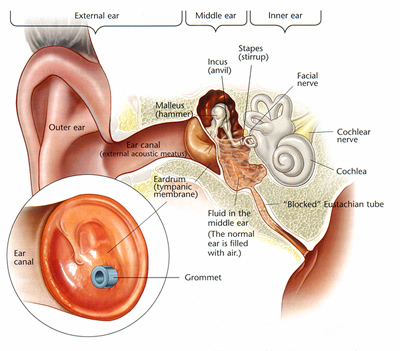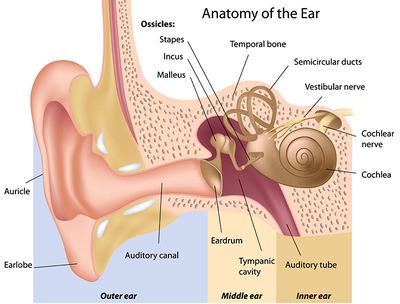Myringotomy Tubes and Ear Ventilation Tubes
Painful ear infections are a rite of passage for children and by the age of five, nearly every child has experienced at least one episode. Most ear infections either resolve on their own (viral) or are effectively treated by antibiotics (bacterial). But sometimes ear infections and/or fluid in the middle ear may become a chronic problem leading to other issues, such as hearing loss, poor school performance, or behavior and speech problems. In these cases, insertion of an ear tube by an otolaryngologist (ear, nose, and throat specialist) may be considered.
Possible Complications
Myringotomy with insertion of ear tubes is an extremely common and safe procedure with minimal complications. When complications do occur, they may include:
- Perforation: This can rarely happen when a tube comes out or a long-term tube is removed and the hole in the tympanic membrane (ear drum) does not close. The hole can be patched through a surgical procedure called a tympanoplasty or myringoplasty.
- Scarring: Any irritation of the ear drum (recurrent ear infections), including repeated insertion of ear tubes, can cause scarring called tympanosclerosis or myringosclerosis. In most cases, this causes no problem with hearing and does not need any treatment.
- Infection: Ear infections can still occur with a tube in place and cause ear discharge or drainage. However, these infections are usually infrequent, do not cause hearing loss (because the infection drains out), and may go away on their own or be treated effectively with antibiotic ear drops. Oral antibiotics are rarely needed.
- Ear tubes come out too early or stay in too long: If an ear tube expels from the ear drum too soon (which is unpredictable), fluid may return and repeat surgery may be needed. Ear tubes that remain too long may result in perforation or may require removal by an otolaryngologist.
What Happens After Surgery
After surgery, the patient is monitored in the recovery room (if general anesthesia was used) and will usually go home within an hour or two if no complications occur. Patients usually experience little or no postoperative pain, but grogginess, irritability, and/or nausea from the anesthesia can occur temporarily. When done in the office recovery is immediate.
Hearing loss caused by the presence of middle ear fluid is immediately resolved by surgery. Children with speech, language, learning, or balance problems may take several weeks or months to fully improve.
The otolaryngologist will provide specific postoperative instructions, including when to seek attention and to set follow-up appointments. He or she may also prescribe an antibiotic ear drops for a few days. An audiogram should be performed after surgery, if hearing loss is present before the tubes are placed. This test will make sure that hearing has improved with the surgery.
Consultation with an otolaryngologist (ear, nose, and throat specialist) may be warranted if you or your child has experienced repeated or severe ear infections, ear infections that are not resolved with antibiotics, hearing loss due to fluid in the middle ear, barotrauma, or have an anatomic abnormality that inhibits drainage of the middle ear.



